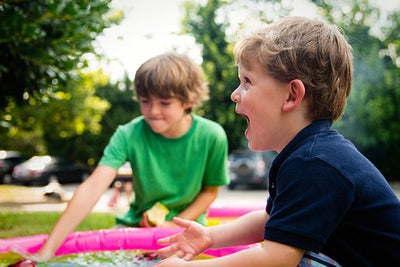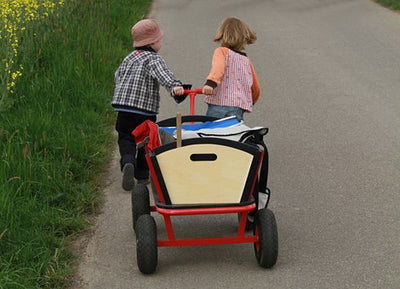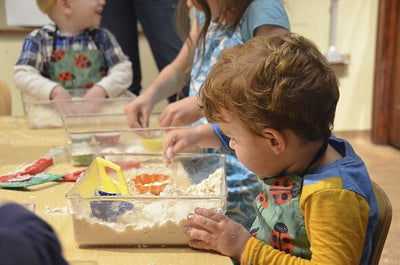
Part 3: The Second Stage of Play
Parallel Play: 2.5 - 3 yrs
We're now to the stage where your child is ready to play within the vicinity of other children, called Parallel Play. During parallel play, your child is playing near peers and with similar toys, but it not yet interacting with them. This might seem strange, but important skills are developed in this early social stage such as observing how other children interact with toys and distinguishing between appropriate and inappropriate “space bubbles”. It is also important to allow your child to take their time becoming comfortable in new situations because other children are “unpredictable”.
Encourage your child to play near their friends, whether this is on the playground or just on the same side of the room as cousins and siblings. If your child comes over to play near you, encourage them to go play by their friends, with some support from you. I love playing with my preschoolers, but it's better to let them learn to play with each other.
If there aren't any peers around, then I gladly and enthusiastically play with them whether it's building a tower of blocks or pretending to make a cake and have a tea party, but if there are any peers around..... then I try to sneak myself out of the play area and if they follow me then I encourage them to return and play by their peers.
It is not always easy to encourage your child to engage with other children on the playground, especially with children they have not met before.
5 tips on how to support positive play interactions:
-
 Sit CLOSE to your child. It is sometimes scary to be around new children, especially ones that your child doesn’t know. In order to create a comfortable atmosphere, you can bring a book with you to the playground and sit within five feet of your child. You are close enough for your child to engage with them if they need any support, but you are “busy” reading which will encourage your child to look towards others for interaction.
Sit CLOSE to your child. It is sometimes scary to be around new children, especially ones that your child doesn’t know. In order to create a comfortable atmosphere, you can bring a book with you to the playground and sit within five feet of your child. You are close enough for your child to engage with them if they need any support, but you are “busy” reading which will encourage your child to look towards others for interaction.
-
 Bring TWO sets of the same toy. One way to encourage your child to engage with other children is to bring more than one of the same toy to the park (such as two sand shovels, two balls, two puzzles, three or four children’s books), etc. While you are playing with your child, invite other children to play by handing them the second object. As long as the objects are similar, your child should be okay with sharing! As the children start to play together, you can “back off” and wait for your child to come to you for support.
Bring TWO sets of the same toy. One way to encourage your child to engage with other children is to bring more than one of the same toy to the park (such as two sand shovels, two balls, two puzzles, three or four children’s books), etc. While you are playing with your child, invite other children to play by handing them the second object. As long as the objects are similar, your child should be okay with sharing! As the children start to play together, you can “back off” and wait for your child to come to you for support.
-
 Sit NEAR a popular area. There are always those “super popular” areas at a park. Some have sand pits, others have swings, others have shaded areas that overlook fun climbing structures. When you get to the park, sit down near these popular areas and say “hi” to a couple parents and children you are near. Point out what the other children are doing to your child such as “Wow, look! Johnny climbed up all four of those stairs! Would you like to try that too?”
Sit NEAR a popular area. There are always those “super popular” areas at a park. Some have sand pits, others have swings, others have shaded areas that overlook fun climbing structures. When you get to the park, sit down near these popular areas and say “hi” to a couple parents and children you are near. Point out what the other children are doing to your child such as “Wow, look! Johnny climbed up all four of those stairs! Would you like to try that too?”
-
 Create opportunities to engage with OLDER Children. Children learn so much from children that are in a higher play stage. Older children tend to LOVE helping the younger ones out, showing them how to complete a task or helping them find an object that they are looking for. Some ways to incorporate other children into your child’s play experience is to ask one to help your child climb up the stairs, or ask if another child has seen a ball that is hiding in the sandbox where they are.
Create opportunities to engage with OLDER Children. Children learn so much from children that are in a higher play stage. Older children tend to LOVE helping the younger ones out, showing them how to complete a task or helping them find an object that they are looking for. Some ways to incorporate other children into your child’s play experience is to ask one to help your child climb up the stairs, or ask if another child has seen a ball that is hiding in the sandbox where they are. -
 Acknowledge that LARGE groups can be overwhelming. It is important to remember that busy children can be very daunting. It is okay for your child to ask for a break from playing. This is a good time for a snack or a quick rest. Talk to your child about all of the things they have done at the park. When they are ready to play again, ask your child to watch the other children and observe what they are doing. Encourage your child to imitate other children’s play, engaging with the children as they feel comfortable.
Acknowledge that LARGE groups can be overwhelming. It is important to remember that busy children can be very daunting. It is okay for your child to ask for a break from playing. This is a good time for a snack or a quick rest. Talk to your child about all of the things they have done at the park. When they are ready to play again, ask your child to watch the other children and observe what they are doing. Encourage your child to imitate other children’s play, engaging with the children as they feel comfortable.
The Parallel Play stage typically lasts from when your child is 30-36 months old. Soon your child will develop more advanced play skills. The next post in this series will describe typical play skills for children ages 3 through 4 years old.
Remember that all children learn differently and at different paces. Development is affected by children’s exposure to a variety of situations. This is a great age to start attending social groups in your area, such as gymnastics, toddler soccer and other activities that encourage play near other children.
For more activities that you can complete with your child at the park, please view the JDEducational Activity Guide: Level 1: Module 10: Park Activities; Creating Successful Transitions.
About the Authors:
 Jeana Kinne is an Early Childhood Developmental Specialist with a Masters in Education. She currently works with infants and toddlers with special needs and blogs at www.jdeducational.com where she shares tips and tricks regarding child development and answers to commonly asked parenting questions. Jeana created simple and engaging learning activities you can do at home with your children, using items you already have at home. You can find these activities at www.jdeducational.com/collections and follow her on Facebook at JDEducational: Preschool & Kindergarten Readiness.
Jeana Kinne is an Early Childhood Developmental Specialist with a Masters in Education. She currently works with infants and toddlers with special needs and blogs at www.jdeducational.com where she shares tips and tricks regarding child development and answers to commonly asked parenting questions. Jeana created simple and engaging learning activities you can do at home with your children, using items you already have at home. You can find these activities at www.jdeducational.com/collections and follow her on Facebook at JDEducational: Preschool & Kindergarten Readiness.
 Leia Knight is Deaf Educator specialized in Listening and Spoken Language. She developed Language for the Playground to answer the WHY and HOW questions. Why children need social and language skills, why certain skills are important, how to teach these skills, and how these skills affect a child’s functioning in the real-world. Leia discusses strategies, tips and research to answer all your language, listening and social skills questions at languagefortheplayground.com.
Leia Knight is Deaf Educator specialized in Listening and Spoken Language. She developed Language for the Playground to answer the WHY and HOW questions. Why children need social and language skills, why certain skills are important, how to teach these skills, and how these skills affect a child’s functioning in the real-world. Leia discusses strategies, tips and research to answer all your language, listening and social skills questions at languagefortheplayground.com.


 Sit CLOSE to your child. It is sometimes scary to be around new children, especially ones that your child doesn’t know. In order to create a comfortable atmosphere, you can bring a book with you to the playground and sit within five feet of your child. You are close enough for your child to engage with them if they need any support, but you are “busy” reading which will encourage your child to look towards others for interaction.
Sit CLOSE to your child. It is sometimes scary to be around new children, especially ones that your child doesn’t know. In order to create a comfortable atmosphere, you can bring a book with you to the playground and sit within five feet of your child. You are close enough for your child to engage with them if they need any support, but you are “busy” reading which will encourage your child to look towards others for interaction. Bring TWO sets of the same toy. One way to encourage your child to engage with other children is to bring more than one of the same toy to the park (such as two sand shovels, two balls, two puzzles, three or four children’s books), etc. While you are playing with your child, invite other children to play by handing them the second object. As long as the objects are similar, your child should be okay with sharing! As the children start to play together, you can “back off” and wait for your child to come to you for support.
Bring TWO sets of the same toy. One way to encourage your child to engage with other children is to bring more than one of the same toy to the park (such as two sand shovels, two balls, two puzzles, three or four children’s books), etc. While you are playing with your child, invite other children to play by handing them the second object. As long as the objects are similar, your child should be okay with sharing! As the children start to play together, you can “back off” and wait for your child to come to you for support. Sit NEAR a popular area. There are always those “super popular” areas at a park. Some have sand pits, others have swings, others have shaded areas that overlook fun climbing structures. When you get to the park, sit down near these popular areas and say “hi” to a couple parents and children you are near. Point out what the other children are doing to your child such as “Wow, look! Johnny climbed up all four of those stairs! Would you like to try that too?”
Sit NEAR a popular area. There are always those “super popular” areas at a park. Some have sand pits, others have swings, others have shaded areas that overlook fun climbing structures. When you get to the park, sit down near these popular areas and say “hi” to a couple parents and children you are near. Point out what the other children are doing to your child such as “Wow, look! Johnny climbed up all four of those stairs! Would you like to try that too?”
 Create opportunities to engage with OLDER Children. Children learn so much from children that are in a higher play stage. Older children tend to LOVE helping the younger ones out, showing them how to complete a task or helping them find an object that they are looking for. Some ways to incorporate other children into your child’s play experience is to ask one to help your child climb up the stairs, or ask if another child has seen a ball that is hiding in the sandbox where they are.
Create opportunities to engage with OLDER Children. Children learn so much from children that are in a higher play stage. Older children tend to LOVE helping the younger ones out, showing them how to complete a task or helping them find an object that they are looking for. Some ways to incorporate other children into your child’s play experience is to ask one to help your child climb up the stairs, or ask if another child has seen a ball that is hiding in the sandbox where they are. Acknowledge that LARGE groups can be overwhelming. It is important to remember that busy children can be very daunting. It is okay for your child to ask for a break from playing. This is a good time for a snack or a quick rest. Talk to your child about all of the things they have done at the park. When they are ready to play again, ask your child to watch the other children and observe what they are doing. Encourage your child to imitate other children’s play, engaging with the children as they feel comfortable.
Acknowledge that LARGE groups can be overwhelming. It is important to remember that busy children can be very daunting. It is okay for your child to ask for a break from playing. This is a good time for a snack or a quick rest. Talk to your child about all of the things they have done at the park. When they are ready to play again, ask your child to watch the other children and observe what they are doing. Encourage your child to imitate other children’s play, engaging with the children as they feel comfortable.

